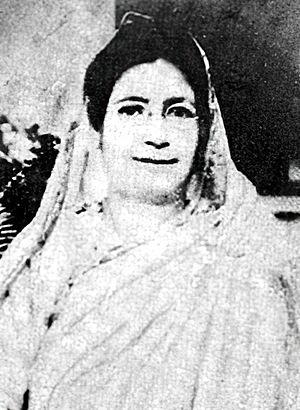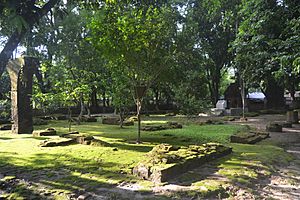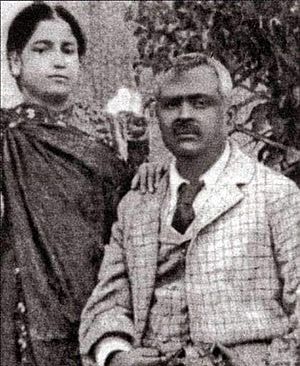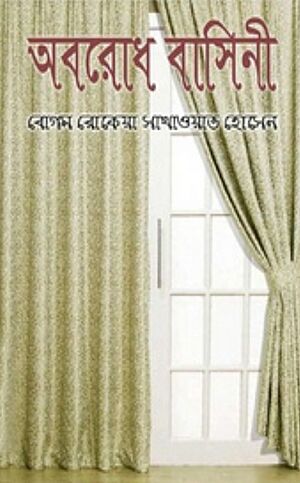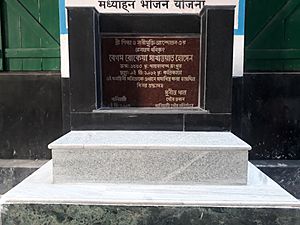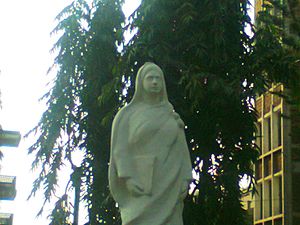Begum Rokeya facts for kids
Begum Rokeya Sakhawat Hossain (born Rokeya Khatun; 9 December 1880 – 9 December 1932) was a very important Bengali writer, teacher, and activist. She is known for fighting for the rights and education of girls and women, especially Muslim girls, in what is now Bangladesh and India.
Many people see her as a pioneer for women's freedom in South Asia. Rokeya believed that boys and girls should be treated equally. She thought that if girls didn't get an education, they couldn't have good jobs or be independent.
Her most famous books include Matichur (a collection of essays), Sultana's Dream (a science fiction story about a land ruled by women), and Abarodhbasini (which criticized strict rules that kept women hidden).
Rokeya strongly believed that education was key for women to be free. She started the first school mainly for Muslim girls in Kolkata. She even went door-to-door to convince parents to send their daughters to her school. She kept the school running despite many challenges and criticisms.
In 1916, she created the Muslim Women's Association. This group worked hard to get women educated and employed. She also led a big meeting in Kolkata in 1926 to support women's education rights. She continued to fight for women's progress until she passed away.
Every year on 9 December, Bangladesh celebrates Rokeya Day to remember her work. On this day, the government also gives out the Begum Rokeya Padak award to women who have achieved great things. In 2004, the BBC ranked Rokeya as one of the greatest Bengalis of all time.
Contents
Her Early Life and Family
Rokeya was born in 1880 in a wealthy Bengali Muslim family in a village called Pairaband. This village was in what was then Bengal, which is now part of Bangladesh. Her family had moved from Iran a long time ago and were important landowners.
Her father, Zahiruddin Muhammad Abu Ali Haidar Saber, was a landowner and very smart. Rokeya had two sisters and three brothers. Her older brother, Ibrahim Saber, and her older sister, Karimunnesa Khanam Chaudhurani, greatly influenced her life.
Karimunnesa wanted to learn Bengali, which was unusual for girls in her family. Ibrahim taught both Rokeya and Karimunnesa English and Bengali. This was very important because at that time, many families preferred to teach Arabic and Persian.
Her Marriage and Support
Rokeya got married in 1898 when she was 18 years old. Her husband was Khan Bahadur Sakhawat Hossain, a government official from Bhagalpur. He had studied in England and was a very open-minded person.
He strongly encouraged Rokeya to keep learning Bengali and English. He also told her to write, and because of his advice, she chose Bengali as the main language for her books.
Her Amazing Writings
Rokeya started her writing career in 1902 with an essay called Pipasa (which means Thirst). She later published Matichur (1905) and Sultana's Dream (1908).
In Sultana's Dream, Rokeya imagined a world where women were in charge and men stayed at home. In this story, women used amazing inventions like solar ovens and flying cars to help everyone. This book is seen as a clever and important satire.
She wrote regularly for many magazines and newspapers, sharing her ideas.
Five months after her husband passed away in 1909, Rokeya opened a high school. She named it Sakhawat Memorial Girls' High School. It started in Bhagalpur with only five students. Because of a disagreement with her husband's family, she moved the school to Kolkata in 1911. She managed the school for 24 years.
Rokeya also founded the Anjuman-e-Khawateen-e-Islam (Islamic Women's Association). This group held discussions and meetings about women's status and education. She believed that old-fashioned ideas and strict traditions were slowing down the progress of Muslims in British India. The association organized events to bring about social changes based on the true teachings of Islam.
Her Writing Style
Rokeya wrote different types of works, including short stories, poems, essays, and novels. She had a unique writing style that was creative, logical, and often funny. She started writing for a magazine called Nabanoor around 1903. Her writings encouraged women to speak out against unfairness and break down social barriers that held them back.
Important Books by Begum Rokeya
- Pipasha ("Thirst") (1902)
- Matichur 1st Vol. (Essays) (1904)
- Matichur 2nd Vol. (Essays) (1922)
- Sultana's Dream (1905)
- Padmarag ("Essence of the Lotus") (novel) (1924)
- Abarodhbasini ("The Secluded Women") (1931)
- Boligarto (short story)
- Narir Adhikar ("The Rights of Women"), an unfinished essay
- God Gives, Man Robs (1927)
- Education Ideals for the Modern Indian Girl (1931)
Her Death and Lasting Impact
Rokeya passed away from heart problems on 9 December 1932, which was also her 52nd birthday.
As mentioned, 9 December is celebrated as Rokeya Day in Bangladesh. On 9 December 2017, Google honored her 137th birthday with a special Google Doodle.
Her grave was found again in Sodepur thanks to a historian named Amalendu De. It is located inside the Panihati Girls' High School.
Rokeya is seen as the first feminist of Bengal. Many universities, public buildings, and a national award in Bangladesh are named after her. She inspired many female writers who came after her.
Places and Awards Named After Her
- Begum Rokeya Day: A day to remember her birth and death, celebrated every year on 9 December in Bangladesh.
- Begum Rokeya Padak: A national award in Bangladesh given to women for their outstanding achievements.
- Begum Rokeya Memorial Center: A place for learning and culture in Pairaband, Bangladesh.
- Rokeya Shoroni: A road in Dhaka.
- Begum Rokeya University: A public university in Bangladesh.
- Rokeya Hall: The largest residential hall for female students at the University of Dhaka. Other universities like Khulna University of Engineering and Technology, Bangladesh Agricultural University, and Rajshahi University also have halls named after her.
- Sakhawat Memorial Govt. Girls' High School: The school she founded in Kolkata.
- Begum Rokeya Smriti Balika Vidalaya: A girls' school in Saltlake, West Bengal.
See also
 In Spanish: Begum Rokeya para niños
In Spanish: Begum Rokeya para niños


